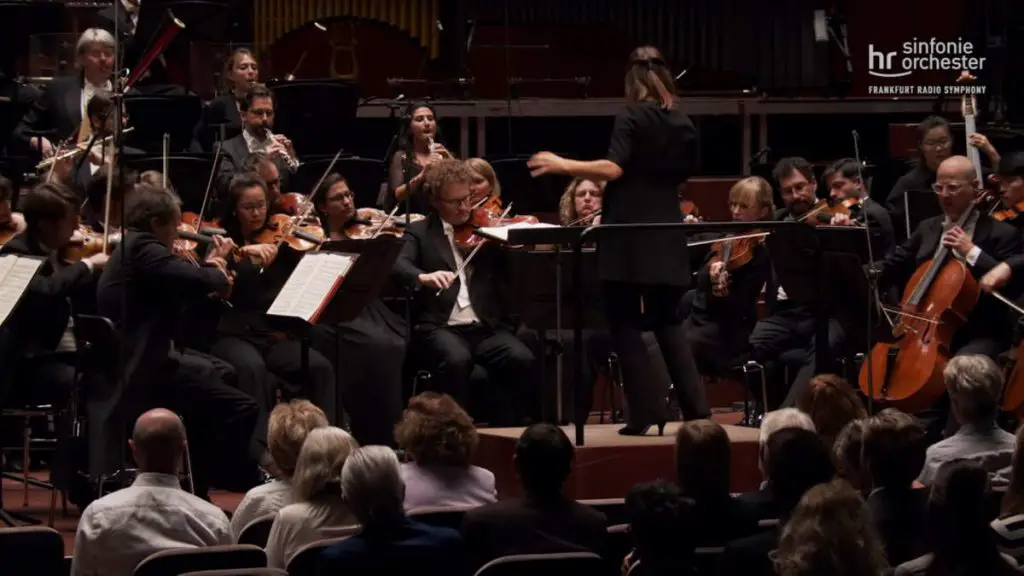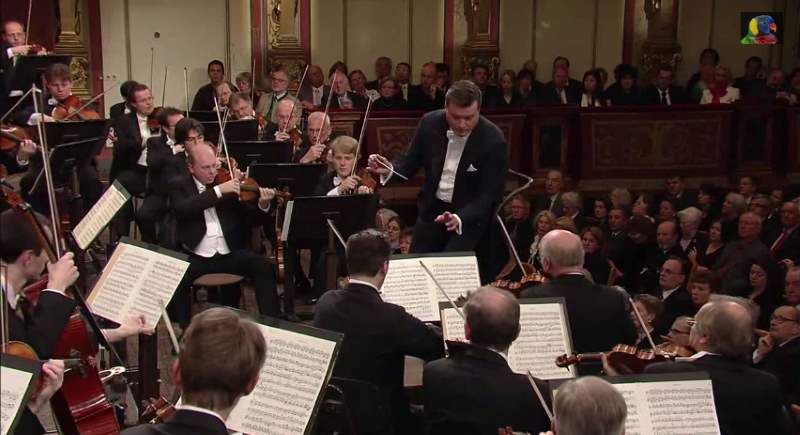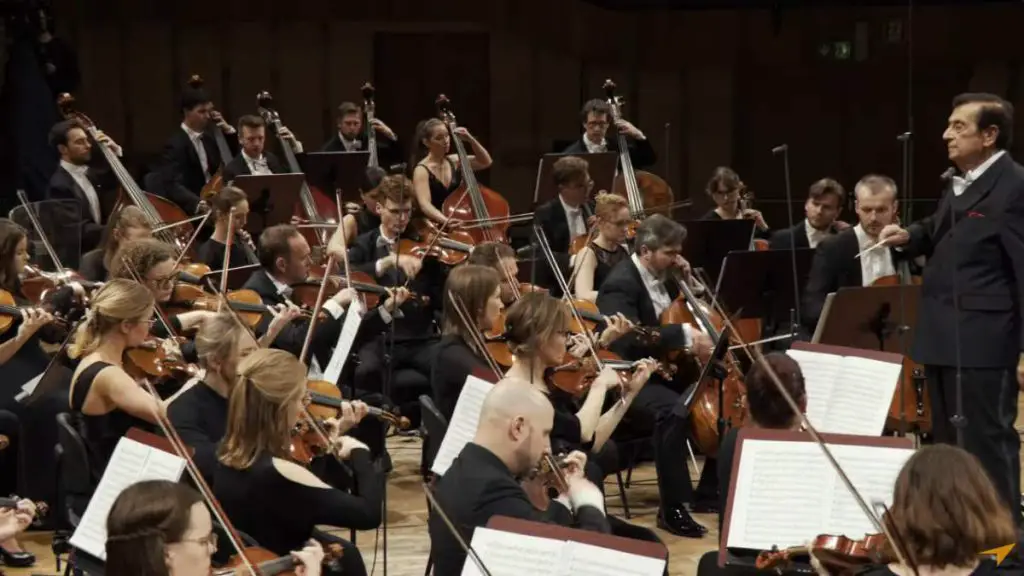Conducted by Jordi Savall, an orchestra performing on period instruments, Le Concert des Nations performs Ludwig van Beethoven’s Symphony No. 6 in F major, Op. 68, also known as the “Pastoral Symphony”. This performance was recorded at the Philharmonie de Paris in 2021.
Ludwig van Beethoven’s Symphony No. 6, the “Pastoral Symphony”
Ludwig van Beethoven’s Symphony No. 6 in F Major, Op. 68, known as the “Pastoral Symphony,” is one of the most profound artistic reflections on nature and its impact on the human spirit. Composed simultaneously with his more dramatic Symphony No. 5, the “Pastoral” represents a marked contrast through its gentle, evocative portrayal of the countryside, which Beethoven loved deeply. The symphony was completed and first performed in 1808 and is often celebrated for its pioneering depiction of programmatic themes -those that tell a story or paint a picture- within a symphonic context.
The “Pastoral” Symphony reflects Beethoven’s profound love of nature, which was for him not just a source of solace but a vital influence on his musical creativity. Unlike many of his other symphonies, which surge with heroic vigor, the Sixth Symphony exudes a sense of calm, joy, and contemplation. Beethoven himself subtitled the work “Recollections of Country Life,” emphasizing that it is “more the expression of feeling than painting.” This distinction underlines that the symphony is meant to evoke the emotions one might feel in the countryside rather than explicitly mimicking the sounds of nature.
Beethoven’s deep connection with nature can be understood as a response to the tumultuous times he lived in. The late 18th and early 19th centuries were periods of immense social and political change, with the Napoleonic Wars reshaping Europe. In such a climate, the pastoral tranquility depicted in Symphony No. 6 offered a peaceful sanctuary. The symphony’s structure and content suggest a narrative flow, taking listeners through the pleasures of arriving in the countryside, experiencing its scenes, and even being caught in a storm before everything resolves into a peaceful conclusion.
The symphony is celebrated for its innovative use of the orchestra to evoke these pastoral scenes. Beethoven’s orchestration creates vivid soundscapes that conjure images of a lush countryside replete with murmuring brooks, singing birds, and rumbling storms. This approach was revolutionary at the time and expanded the expressive capabilities of the symphonic form. It also anticipated the programmatic expressions found in the later Romantic symphonies, influencing composers like Mendelssohn, Berlioz, and Mahler.
Additionally, the “Pastoral” Symphony stands out for its emotional breadth, moving seamlessly from serene and idyllic to joyful and exuberant, and then to dramatic and forceful during the storm, before returning to a state of divine calm. This symphony reveals Beethoven’s mastery in sculpting sound to mirror the nuances of human emotions and the natural world, a testimony to his genius in bridging the Classical and Romantic eras of music.
In essence, Symphony No. 6 is not just a musical work but a celebration of nature’s beauty and its restorative qualities. It invites listeners to escape from the strife of their everyday lives into a world of pastoral beauty and tranquility, demonstrating Beethoven’s exceptional ability to translate his personal experiences and feelings into universal art. Through the “Pastoral” Symphony, Beethoven profoundly communicates the joy, peace, and renewal he found in nature.
Movements
“Pastoral” symphony has five movements, not the usual four, and Beethoven gave them descriptive headings along with the usual tempo indications. With start times in the video above:
- (00:00) Allegro ma non troppo: ‘Awakening of Cheerful Feelings upon Arrival in the Country’
- (11:01) Andante molto mosso: ‘Scene by the Brook’
- (22:43) Allegro: ‘Merry Gathering of the Country Folk’
- (27:33) Allegro: ‘Storm Movement’
- (31:30) Allegretto: ‘Shepherd’s Song. Glad and Thankful Feelings After the Storm’
1. Allegro ma non troppo: ‘Awakening of Cheerful Feelings upon Arrival in the Country’
The first movement of Beethoven’s “Pastoral” Symphony, marked “Allegro ma non troppo,” is titled “Awakening of Cheerful Feelings upon Arrival in the Country.” This movement serves as an opening chapter to the symphonic narrative, inviting the listener into Beethoven’s idealized, serene vision of the countryside. The tempo indication, “Allegro ma non troppo” (fast, but not too much), perfectly captures the balance between the joyful anticipation of being in nature and a leisurely pace, suggesting a gentle, unhurried enjoyment of the rural landscape.
Musically, this movement is characterized by its flowing melodies and a clear, open structure that mirrors the openness of the countryside. The main theme is simple yet full of warmth, introduced by the violins and then woven throughout the orchestra, creating a lush, harmonious texture. This thematic material evokes the image of a tranquil landscape, untouched and abundant in its natural beauty.
The orchestration in this movement reflects a pastoral simplicity. The use of repetitive motifs mimics the repetitive sounds of nature, such as the rustling leaves or a gentle breeze. These motifs are layered over each other, building a texture that feels both rich and expansive. The overall effect is calming and enveloping, encapsulating the listener in a musical representation of the countryside.
Beethoven’s genius in this movement lies in his ability to convey the sense of release and refreshment that one feels upon escaping the confines of urban life. The thematic development progresses smoothly, evoking a sense of freedom and space. The movement does not rush but unfolds at its own natural pace, allowing the listener to fully immerse in the cheerful feelings of being surrounded by nature.
This first movement sets the tone for the entire symphony, establishing a connection with nature that is both deeply personal and universally appealing. It reflects Beethoven’s own experiences and love for the countryside, serving as a perfect musical expression of finding joy and peace in the natural world. Through this movement, Beethoven invites listeners to leave behind their daily worries and rediscover the simple pleasures of nature, thus awakening their own cheerful feelings upon arrival in the country.
2. Andante molto mosso: ‘Scene by the Brook’
The second movement of Beethoven’s “Pastoral” Symphony, marked “Andante molto mosso,” is aptly titled “Scene by the Brook.” This movement offers a contemplative, gentle portrayal of a serene stream flowing through the countryside, capturing both the peaceful ambiance and the subtle, intricate sounds of nature. The tempo indication “Andante molto mosso” suggests a flowing movement, evocative of water’s constant yet unhurried movement, which Beethoven translates into musical lines that meander like a brook.
Musically, this movement is distinguished by its delicate and detailed orchestration, which meticulously evokes the sound and feel of water. Beethoven employs a variety of musical techniques to mimic the babbling of the brook, including rippling figures in the strings and woodwinds, and light, fluid passages that suggest the clear, cool water moving over stones and around bends. The motifs are lyrical and elongated, stretching out the time and creating an immersive auditory scene that engages the senses, allowing the listener to imagine the sight and sound of a peaceful brook in a verdant landscape.
One of the most notable features of this movement is Beethoven’s use of tone painting. The repetitive, undulating patterns in the lower strings create a sonic foundation that mimics the continuous flow of water, while the higher strings and woodwinds contribute brighter, sparkling sounds that evoke light reflecting off the water’s surface. This interplay of textures and timbres creates a dynamic yet cohesive sonic picture.
Beethoven also introduces bird-like calls, famously assigned to specific instruments: the flute, oboe, and clarinet. These bird calls are not merely ornamental; they are woven into the fabric of the movement, enhancing the naturalistic feel and deepening the listener’s connection to the scene. This inclusion of bird calls was one of the early examples of such explicit mimetic sounds in orchestral music, showcasing Beethoven’s innovative approach to programmatic composition.
The overall mood of “Scene by the Brook” is one of tranquility and reflection. It invites the listener to pause and appreciate the beauty and simplicity of nature. Through this movement, Beethoven not only celebrates the physical beauty of the natural world but also captures the emotional and psychological rejuvenation that one experiences in such serene settings. This movement, therefore, stands as a testament to Beethoven’s ability to translate visual and emotional landscapes into sound, creating a vivid, dynamic, and deeply moving musical tableau.
3. Allegro: ‘Merry Gathering of the Country Folk’
The third movement of Beethoven’s “Pastoral” Symphony, marked “Allegro,” is titled “Merry Gathering of the Country Folk.” This movement vividly portrays the lively, rustic merriment of a village festival, where the inhabitants come together to dance and celebrate. The tempo “Allegro” reflects the energetic and joyful atmosphere of the gathering, with rhythms and melodies that mimic the folk dances and songs typical of rural community celebrations.
This movement is characterized by its robust, rhythmic energy and straightforward, catchy melodies, which convey the simplicity and earthiness of country life. Beethoven employs a dance-like rhythm throughout, which gives the movement a sense of propulsion and liveliness. The melodies are often presented in a call-and-response format, typical of folk music, enhancing the communal, festive feeling of the movement. These elements combine to create a musical scene that is both dynamic and picturesque, filled with the sounds of jubilation and communal bonding.
The orchestration in this movement is particularly noteworthy for its use of strong, clear textures and vibrant dynamics. Beethoven utilizes the full orchestra to achieve a sound that is full-bodied and resonant, mirroring the collective joy and exuberance of the country folk. The strings drive the rhythmic momentum, supported by punctuations from the brass and woodwinds, which add color and brightness to the musical tapestry.
Further adding to the rustic charm of the movement are the sudden changes in dynamics and the playful interjections by the woodwinds, which simulate the unpredictable, spirited nature of a folk dance. The music vividly evokes images of dancers twirling energetically, clapping, and stomping their feet, fully immersed in the celebration.
This movement of the symphony not only serves as a depiction of a festive scene but also reflects Beethoven’s appreciation of folk traditions and his ability to integrate these into a symphonic context. The “Merry Gathering of the Country Folk” is thus both an homage to the cultural life of the countryside and a celebration of universal joy and community spirit.
Through this lively and engaging movement, Beethoven captures the essence of communal festivity, making it an integral part of his musical exploration of nature and human life within it. This piece stands out as a testament to the composer’s skill in crafting music that is both evocative of a specific time and place and resonant with universal themes of joy and togetherness.
4. Allegro: ‘Storm Movement’
The fourth movement of Beethoven’s “Pastoral” Symphony, marked “Allegro,” is commonly known as the “Storm Movement.” This powerful and dramatic section dramatically shifts the mood of the symphony from the serene and joyous expressions of nature to its more tumultuous and formidable aspect. The “Allegro” tempo conveys the sudden, fierce onset of a storm, with music that encapsulates the elemental force and intensity of nature unleashed.
In this movement, Beethoven masterfully uses the full orchestra to create a soundscape that mimics the gathering, bursting, and eventually waning fury of a storm. The music starts with low, rumbling tones in the basses and cellos, evoking the ominous rumble of thunder in the distance. This is quickly joined by the higher strings and woodwinds, which contribute sharp, dissonant chords and rapid scales that rise and fall like gusts of wind and driving rain.
The orchestration is dense and layered, with a heavy use of timpani and brass to enhance the storm’s ferocity. The timpani rolls mimic the continuous rumbling of thunder, while the brass sections add a brassy, blaring quality that resembles the howling wind. The overlapping textures and sudden dynamic changes enhance the chaotic and unpredictable nature of a storm, creating a vivid auditory experience of being caught in a severe weather event.
Beethoven’s use of musical motifs and their development throughout the movement evoke the progression of the storm. The motifs are introduced, developed, and then intertwined, mirroring how storm clouds gather, peak, and finally dissipate. The tension builds as the music increases in volume and intensity, reaching a climax that feels both overwhelming and awe-inspiring, before gradually tapering off to a quieter, more subdued passage that suggests the storm’s passing.
The “Storm Movement” is a brilliant example of programmatic music, where Beethoven not only aims to paint a picture with sounds but also to evoke the emotional and physical sensations of experiencing a storm in the countryside. This movement serves as a dramatic contrast to the preceding movements, highlighting nature’s dual capacity for beauty and terror.
Through this intense musical portrayal, Beethoven communicates a profound respect and reverence for the power of nature, a theme that resonates with the Romantic ideal of nature as a source of sublime emotions and existential reflection. The “Storm Movement” stands out as a key dramatic moment in the “Pastoral” Symphony, encapsulating the unpredictable and awe-inspiring aspects of the natural world.
5. Allegretto: ‘Shepherd’s Song. Glad and Thankful Feelings After the Storm’
The fifth and final movement of Beethoven’s “Pastoral” Symphony, marked “Allegretto,” is titled “Shepherd’s Song. Glad and Thankful Feelings After the Storm.” This movement serves as a serene and uplifting conclusion to the symphony, encapsulating the relief and joy that permeate the countryside after the tempest has subsided. The “Allegretto” tempo conveys a moderate pace that is reflective, yet filled with a gentle joy, symbolizing the return to peace and the gratefulness of the rural inhabitants for the storm’s end.
Musically, this movement is characterized by its lyrical quality and pastoral simplicity. The melody, primarily carried by the strings, is warm and flowing, suggesting the singing of a shepherd. This melodic line is both comforting and evocative, embodying the tranquil beauty of a landscape cleansed and refreshed by the rain. The use of a simple, repetitive motif throughout the movement adds to the sense of calm and restoration, portraying the steady, rhythmic activities of pastoral life resuming after the storm.
The orchestration in this movement is lighter and more transparent compared to the dense, turbulent textures of the preceding “Storm Movement.” The clear textures and the tender interplay of woodwinds and strings evoke a sense of space and openness, reflecting the cleared skies and the fresh, clean air following the rainfall. The occasional gentle interjections of the horns further enhance the bucolic setting, adding a rustic charm to the musical landscape.
Beethoven’s skillful modulation of dynamics and tempo within the “Allegretto” enhances the narrative quality of the music, effectively conveying the varying emotions of relief and gratitude. The dynamic shifts are subtle, mirroring the gentle fluctuations of a calm and contented heart. The movement builds towards a gentle climax, suffused with warmth, before settling into a quiet and comforting conclusion, leaving the listener with a sense of resolution and thankful repose.
This final movement of the “Pastoral” Symphony is a masterful portrayal of the emotional and physical renewal that follows after a natural upheaval. Beethoven uses the “Shepherd’s Song” to express a universal human response to the passing of danger—a deep-seated gratitude and a renewed appreciation for peace and stability.
Through this movement, Beethoven not only concludes his musical ode to nature but also encapsulates a profound understanding of human emotion in relation to the natural world. The “Shepherd’s Song” stands as a testament to Beethoven’s ability to convey deep emotional truths through music, offering a message of hope and renewal that resonates well beyond its pastoral origins.
Le Concert des Nations
Le Concert des Nations is an orchestra dedicated to performing orchestral and symphonic repertoire from the Baroque to the Romantic periods, covering music from 1600 to 1900. Founded in 1989, it is the youngest ensemble led by Catalan maestro and viola da gamba virtuoso Jordi Savall.
Unique among period orchestras, Le Concert des Nations primarily consists of musicians from Latin countries, including Spain, South America, Italy, Portugal, and France, among others. The ensemble’s name pays homage to Les Nations by François Couperin, symbolizing an assembly of different “tastes” and embodying the spirit of the Age of Enlightenment. Le Concert des Nations also serves as the orchestra for La Capella Reial de Catalunya.

Sources
- Symphony No. 6 (Beethoven) on Wikipedia
- “Understanding Beethoven’s Symphony No. 6: The Pastoral Journey” on the LV Beethoven website
- Symphony No. 6 in F, Op. 68 “Pastoral” on the Eastman School of Music website
- “Beethoven’s Symphony No. 6 ‘Pastoral’: a guide to this supremely evocative masterpiece” on the BBC Classical Music website
- “Beethoven’s Pastoral Symphony” on the Oslo Philharmonic website



I wouldn’t recomend any of those. They are far from first choice and do not transmit the essence of the work. Chose instead Gunter Wand, Riccardo Chailly , Harnoncourt or the great Jos von Immerseel.